Despite prohibition since 1993, the use of anti vegetative paints on boats continues to pollute the marine ecosystems. A study made between November 2015 and May 2016, in Nazaré, shows that there are females of molluscs with sexual male characteristics. They become sterile, putting in danger the ecological balance.
The industrial development and the manufacture of synthetic chemical compounds have caused several problems in ecosystems. One of the synthetic compounds which has caused great problems and already prohibited in many countries, including Portugal, is TBT (tributil of tin), a biocide in anti vegetative paints, used in the prevention of bio incrustation, that is, to avoid the organisms on the boat surfaces, which cause the corrosion of the hull. It is an organic compound with tin, highly toxic and lethal to several organisms.
The exposition to TBT causes an endocrinal disruption which leads to the masculinisation of gastropod females, that is, the appearance of sexual male characteristics (deferent vase and/or penis). This phenomenon, named imposex, is used as a bio marker of pollution by TBT. Ana Barros, a researcher in Universidade de Aveiro, highlights that the relation cause-effect between the exposition to TBT and imposex is proved since the eighties in the 20th century.
A group of students of Colégio Valsassina developed a project trying to study the levels of imposex caused by TBT on molluscs of species Nassarius reticulatus in the area of Nazaré and then they obtained a bio indication of water contamination.
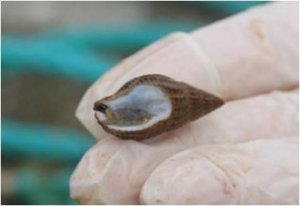
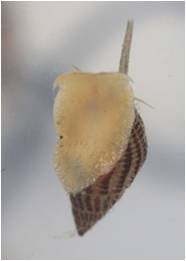
An exemplar of Nassarius reticulates, collected during the study period. It has a spiral shell and a decoration in the shape of a reticulated pattern.
About 150 exemplars were collected at the port of Nazaré to develop the study. A baited eel-buck was used in the gathering. Later, after adults having been selected, 116 individuals were analysed in laboratory. According with the researcher Ana Sousa, Universidade de Aveiro, the international rules to the analysis of imposex define a minimum of 15 females so that the study can be reliable.
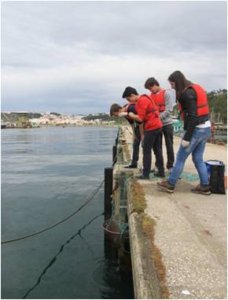
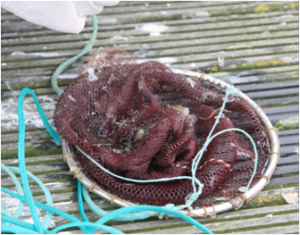
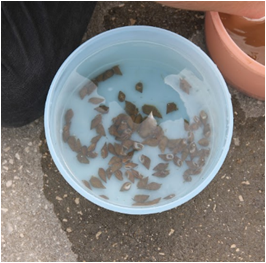
Capture of organisms, using an eel-buck, to analyse cases of imposex.
The analysis to the imposex was made by means of a lens. First, the sex was determined, then the penis was measured both in males and females and, in the latter ones, the sequence of the deferent vase was evaluated.
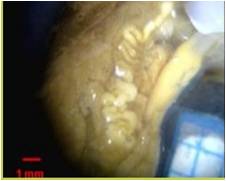
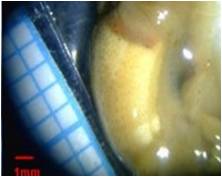
Seminal vesicle Gland of the capsule and oviduct
The identification of the sex is based on the presence of a white seminal vesicle in the males and a gland of the white capsule as well as an orange oviduct in the females. (Source, Barros and al, 2014).
The results show that from 50 analysed females 46 present imposex, which suggests that, in Nazaré, TBT is highly concentrated.
When females reveal imposex, the deferent vase blocks the vulva, making them sterile, leading the population to the risk of disappearance, as well as the trophic chain, unbalancing the ecosystem.
| Nr
males |
H males
(mm) |
MPLI (mm) | Nr
females |
H females
(mm) |
FPLI
(mm) |
VDSI
(average)
|
I
(%) |
| 56 | 20,93 | 11,5 | 55 | 21,97 | 6,5 | 1,97 | 92 |
Results from the study: Sex determination; height (H); average penis length in males (MPLI); average penis length in females (FPLI); imposex development stage in females (VDSI); imposex incidence tax (I).
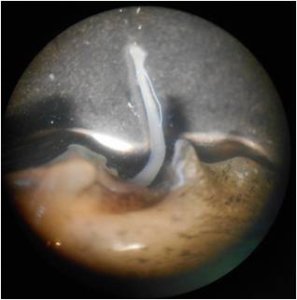
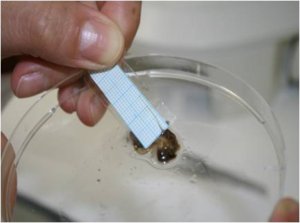
Female with imposex (it shows a developed penis, about 15 mm).
These results are similar to the ones presented in the investigation by Barros et al. (2014), where the presence of imposex in Aveiro and Viana de Castelo was shown.
Ana Barros, researcher in Universidade de Aveiro, highlights that “imposex is an irreversible phenomenon”, therefore the results express the answer of the animals to a continuous accumulation of TBT during their life.
Until its prohibition in Portugal in 1993, TBT was excessively used in paint for boats. Some studies (Sousa, 2004; Wergikoski, 2010; Barros et al. 2014; Laranjeiro, w.d.) reveal that many areas of the Portuguese coast still have cases of imposex, but the reduction of TBT in the waters is being slower than expected. Ana Barros states that TBT doesn’t degrade quickly, besides it can accumulate in the sediments at the bottom of the sea. Reinforcing, in an investigation in the Portuguese coast by the Environmental Portuguese Agency in 2010, it is referred that TBT is present in several organisms, and it is clear the relationship between this compound and the index of imposex observed in these organisms.
There is national legislation and also an European (European Union) and international legal frame about the use of anti vegetative paints with TBT. The compounds of TBT are included in the “List of chemical products of priority action” of Oslo and Paris Convention as well as they are listed as priority substance in the Directive- Board Water.
Besides the chemical monitoring of TBT, the evaluation of imposex is also a compulsory element of Co-ordinated Environmental Monitoring Programme of OSPAR. For the Nassarius reticulatus this organization fixes the average of VSDI in a maximum of 0.3. Over this value the ecological quality isn’t reached. In Valsassina’s study the obtained value is 1.97 (6.6 higher).
This investigation shows the inefficacy of the previously introduced legislative measures as well as the occasional illegal use of paints with this compound, which should be investigated. Some fishermen and owners of boats were contacted but they didn’t confirm if they use anti vegetative paints with TBT.
This is an invisible problem for many people, since the majority of the organisms don’t die due to TBT, although there is an endocrinal disruption. Direct or indirectly, this problem also affects the human being.
This study makes appear several challenges: how to develop new anti vegetative paints which are functional and sustainable at an economical and ecological level? Which are the consequences for the human being when exposed to TBT?
The capacity of the marine environment to assimilate substances of anthropogenic nature isn’t unlimited. But how long do we have to wait TBT is no problem?
We thank to:
Professor Ana Sousa who, from the beginning, was always available to support us, giving highly useful advice. She helped us to find the correct way of our investigation, supervising all its stages and being available even when it was geographically far.
Ana Barros helped us not only in our expedition to Nazaré to collect Nassarius reticulatus but also gave us, personally, valuable knowledge and so we could identify the necessary characteristics in the specimens in order to have a professional and correct study. Her availability, presence and kindness were determinant for the development of our project.
The Administration of the port of Nazaré for their attention and permission to accede to the port so that we could do the field work. Without their support the study in this area wouldn’t have been possible.
Bibliography
Barros, A.R; Mendes, R.T.; Santos, G.C; Sousa, A. (2014)
NOTE: Except the photos related to the sex identification, all the others were shot during the project by its authors.
Afonso Mota, Bernardo Alves, João Leal
Colégio Valsassina, Lisbon, Portugal



You must be logged in to post a comment.